Attractions
GUANAJUATO: The host City
In 1548 the Spaniards, who had settled in the region in 1529, discovered rich outcrops of silver at Guanaxhuata, which means 'Frog Hill' in the Tarasco language. To protect prospectors, miners and the new settlers, four fortified structures were erected at Marfil, Tepetapa, Santa Ana and Cerro del Cuarto, and formed the nuclei of the later town of Guanajuato. Sprawling through a winding valley at an altitude of 2,084 m, Guanajuato differs from the other colonial towns in New Spain because it was not laid out on the standard grid plan. Instead, the scattered areas grew together through the spontaneous urbanization of suitable sites on the rough, natural terrain.
Founded when the silver mines were opened, Guanajuato had a symbiotic relationship with them until the 19th century. Its growth, the layout of its streets, including the picturesque 'subterranean' streets, its plazas, and the construction of hospitals, churches, convents and palaces are all inextricably linked with the industrial history of the region which, with the decline of the Potosí mines in the 18th century, became the world's leading silver extraction centre.
Guanajuato is an outstanding example of an architectural ensemble of a mining operation. Just as the major 18th-century hydraulic works are inextricably linked to an urban topography determined by the confines of the river path and mineral outcrops, so the splendour of the Baroque buildings is directly linked to the wealth of the mines. The churches of La Compañía (1745-65) and above all La Valenciana (1765-88) are masterpieces of the Mexican Churrigueresque style.
Tourist Attractions in Guanajuato

The Templo de Belen or the Parish of the Immaculate Heart of Mary, sits in front of the Mercado Juarez. Bethlemite Monks who came from Guatemala built it as part of an architectural complex which had a cemetery, a school, a group home and gardens.
One of the most remarkable characteristics of the Church of Belen is in the vault beneath the main altar that holds about 300 crypts, with the oldest dating back to the late 18th century
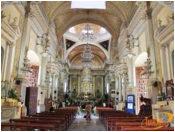
The building of the Basilica of Our Lady of Guanajuato Collegiate began in 1671 and was completed 25 years later, sponsored by the miners in the area. It was elevated to the rank of Basilica in 1957.
The interior of this magnificent baroque building is characterized by its high altar of gold that protects a virgin who has become the patron and queen of the city: Our Lady of Guanajuato, anonymous Virgin of Andalusia and the oldest image to come to America.
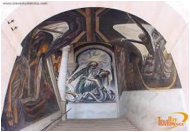
This building of great historical value was formerly used as a grain warehouse for the city of Guanajuato.
Today it serves as proof of the economic boom that reached this mining center towards the last quarter of the 18th century.
It was the setting for the beginnings of the War of Independence of Mexico.
The rooms have important collections that tell about the evolution of the state, from pre-Hispanic times up to the past century.

The Plaza de la Paz was considered to be the main plaza before the Jardin Union came to be. It was placed in a similar way to other zocalos in cities founded by the Spanish in the then New Spain.
It is located in the historic downtown of Guanajuato, just opposite the Cathedral Basilica of Our Lady of Collegiate Guanajuato. It is surrounded by colonial buildings, banks, and restaurants which in earlier times were the residences of Counts and important men.
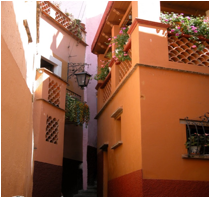
The Alley of the kiss
Legend has it that there lived two people in love called Carlos and Ana. Ana was a rich Spaniard who lived on the left side of the street, and Carlos, a poor miner who would rent the house on the right side for a few gold and silver coins.
Of course the father of Ana did not want her to marry him because he was very poor. He wanted a rich man of the same class to marry his daughter. One night the father surprised the young lovers, when he found them kissing, shoulder to shoulder, reaching out from the balconies of the houses.
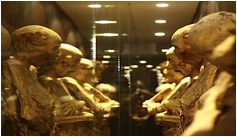
Mummies Museum in Guanajuato
This museum exhibits mummified bodies, perfectly preserved by the minerals in the soil of the civil cemetery.
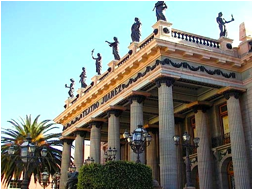
Juarez Theatre
Is regarded as one of the most beautiful theaters in Mexico. Of special splendor is its Roman Doric portico. |


